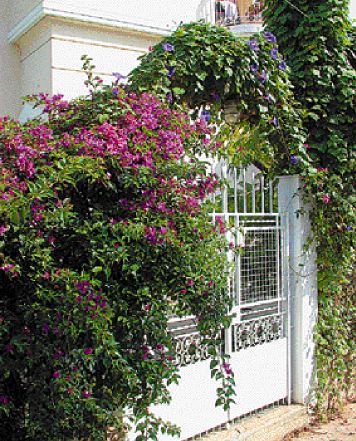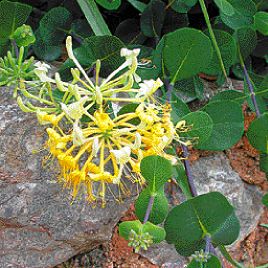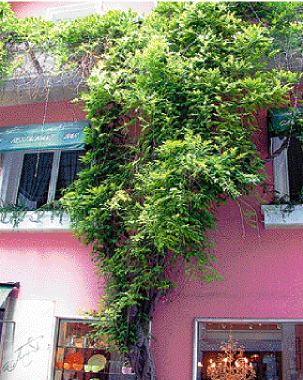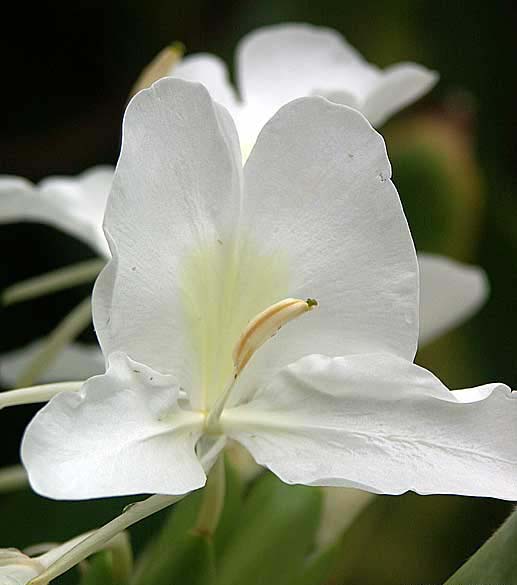 |
||
|
The Sky is the Limit
|
||
|
By Jennifer Gay Athens News Climbers like bougainvillaea and wisteria can thrive on balconies. Just make sure they have enough root room, as well as regular food and water, and they will reward with vigorous growth Many people love the idea of growing climbers but wonder if it is possible within the confines of a balcony. Though they may not perform as they would in open ground, many climbers will adapt to balcony life. Given their high flowering to space ratio, they are very useful in a restricted area, taking up limited ground space yet still covering a wall with glossy foliage and scented blooms. What you must do is make sure your climbers have an adequately sized container to allow the roots to develop - you will probably need to pot on a few times before the climber reaches a certain size and |
 Bougainvillaea with morning glory |
|
| becomes settled in the container that will be its longterm home. Even then, you will need to be vigilant about watering and feeding. During the summer your potted climber will almost certainly need watering every day. A twice yearly application of slow-release fertiliser (in March and October) is necessary and in the case of fast growers such as bougainvillaea, a once-a-month-feed during the growing season with liquid fertiliser will help things along. The more vigorous the climber, the more attention it will need - for example, bougainvillaea and wisteria will need root pruning every few years or they will quickly outgrow their pots and exhaust their nutrient supplies. However, if you are willing to carry out these occasional but crucial maintenance tasks, the sky's the limit, so to speak. Aside from the challenge of limited space, balconies are often exposed to high winds. They get little protection from the elements without the buffer afforded by trees, shrubs, hedges and fences as do gardens on ground level. Air turbulence stirred up between tall buildings adds to the problem. One solution is to put up trellis or netting - not only to provide support for climbing plants but also to give initial protection from the wind. Resist temptation to build a solid wall as that will itself cause turbulence: the best windbreaks are 50 percent permeable. If you choose netting, select a small mesh size - the bigger the mesh the less effective the windbreak. Make sure it is securely fixed - the extra wind resistance produced by the foliage of the climbers as they start to clamber over the net could turn your windbreak into a sail flapping in the wind. |
||
| Ivies (Hedera spp) and honeysuckles (Lonicera spp) are happy in shade and will do well next to a wall even under a deep overhang. Both are also wind tolerant. Honeysuckle of course has the advantage of spring-time sweetly-scented flowers. However, it will need some control and occasional root pruning if it is not to outgrow its space and quickly tire. Prune by removing the old wood after flowering - this is best done every year or it will become messy. Virginia creeper (Parthenocissus quinquefolia) is another vigorous climber that nonetheless thrives in a pot. Trouble free with little pruning required, in return it clothes a wall in brilliant colour for autumn - and will do so in semi-shade or sun. |
 Ionicera Implexa |
|
|
For full sun and a dash of classic Mediterranean style, bougainvillaea is the obvious choice. It responds well to hard pruning if it outgrows its situation. There are many cultivars based on Bougainvillaea glabra, however, the parent is the toughest - purple-magenta coloured, it seems to tolerate wind best. You will definitely need to keep on top of dealing with those long outshoots, either pruning to control or tying in to trellis to create a framework of growth. Wisteria is another vigorous climber once it gets going, and will need twice yearly pruning in June and February to keep manageable. The flowering season is short but stunning, but I would grow wisteria for the foliage alone. Common Jasmine (Jasminium officinale) is a delight for its night-scented perfume, however you will need to keep it out of the wind and in a semi-shaded position for best results. Control growth by regularly pinching out growing tips, and tying into a network of wires or trellis. I find the star jasmine (Tracheliospermum jasminoides) to be hardiest of all, coping with sun and shade, and wind tolerant to boot. Evergreen and with a long, scented flowering period, it offers a lot to a small space. |
||
| Annual climbers are a convenient container solution for fast cover and colour - Morning Glory (Ipomoea spp) or Sweet Peas can be sown from seed each year to give you a great summer display (extending well into autumn in the case of Morning Glory). Though annuals die when they finish flowering, it is so easy to start all over again the next year. Support system Climbers need support, even if only initially, and you can do this either by providing support within the pot itself or by placing the pot close enough to a supporting pillar or wall. By fixing a support in the container, the plant becomes independent and can be moved around as desired. The way in which the climber grows will determine the nature of the support and the degree of help needed. Self clinging climbers like ivy and Virginia creeper need very little help - just point them in the right direction and secure them against the surface they are to climb until they start to cling - best against the solid surface of a wall. |
 Wisteria |
|
| Twiners such as honeysuckle, jasmine and clematis need wire or wooden trellis. Secure wall supports firmly allowing a gap of about 5cm for the plant to clamber. Vigorous honeysuckles become very heavy when in full flower so make sure the support is adequate to take their weight. Planting tips Terracotta pots provide weight for stability - avoid narrow-necked containers as you'll be lucky to recoup both pot and plant after a re-potting exercise. Make sure it is big enough for the rootball, but don't over-pot unless a very fast grower. Check drainage holes are adequate. Add a drainage layer of pebbles or crocks about 5cm thick. Put 5-10cm of soil-based compost in the pot and if using a support place it in the pot now. Gently tease out the roots of the climber and place in pot. Fill the container with compost to 5cm from the brim this leaves space for watering. Spread out the climber's shoots to form a fan-shape. Remove any bamboo canes and ties in the shoots to the support (not too tight). |
||
|
|
||
|
Flowering now
EXOTIC white ginger lily (Hedychium coronarium) is flowering now, its deliciously scented, butterfly-like white blooms gently sweetening the night air. This rhizomatous perennial comes from India and left to grow unhindered can reach 3 metres high. It will also grow happily in a pot, though will not reach 3 metres |
 |
|
| when constrained. Needs plenty of water in the growing season and a balanced liquid fertiliser applied monthly won't go amiss. Ginger lily appreciates a humussy moist but well-drained soil in sun or partial shade. Protect from temperatures under 5 degrees Celsius. |
||
|
Gardeners' queries WHERE can rolls of Mypex be obtained in Greece? Is there a supplier in Ioannina, Corfu or Athens? Mypex is a close woven plastic cloth that is used as a weed suppressant - though it stops weeds growing it allows water to permeate through, therefore permitting drainage. A classic use is for gravel paths - rolled out before the gravel is laid to prevent weed growth in the path. Nurseries also use it as a clean base for pots to stand on. Mypex is available in Greece - well-stocked garden centres often keep it. Try calling Praktiker - there are several branches in Athens including in Elliniko (210-994-6370) and Metamorfosi (210-285-3950). I have usually found it when working on remote islands by asking around - even though they don't necessarily have it on display, nurseries usually have rolls stashed away somewhere and will sell it by the metre. If you have a gardening question for Jennifer Gay, send it to gardening@dolnet.gr |
||
(Posting Date 6 November 2006) HCS readers can view other excellent articles by this writer in the News & Issues and other sections of our extensive, permanent archives at the URL http://www.helleniccomserve.com./contents.html
All articles of Athens News appearing on HCS have been reprinted with permission. |
||
|
||
|
2000 © Hellenic Communication Service, L.L.C. All Rights Reserved. http://www.HellenicComServe.com |
||

